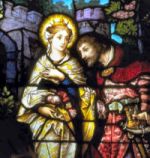Catholic Activity: Las Posadas II
Here is a wonderful description of the tradition of the nine-day custom Posadas, that commemorate the journey of Mary and Joseph from Nazareth to Bethlehem.
DIRECTIONS
Bunuelos are the big crisp fried cakes that Mexicans have for Christmas Eve supper. They are eaten either plain, with cinnamon and brown sugar syrup, or sometimes with honey. But before supper there is the traditional Misa de Gallo, or Mass of the Cock, at the village church. And for nine consecutive nights before that, there are the posadas to commemorate the journey of Mary and Joseph from Nazareth to Bethlehem and their search for lodgings.
The word, posada, means an inn. To the humble Mexican the re-enactment of the Holy Family's quest for lodgings is a ritual of deep religious significance. The posadas, which start on the sixtenth of December and end on Christmas Eve, take place at different houses each night. Since Christmas, to the Mexican, is a community rather than a family affair, relatives and friends in a neighborhood often club together to defray posada expenses. The climax of each is the breaking of the Pinata.
Pinatas are pottery jars, filled with trinkets, candies, and miniature toys. The jars are ingeniously decorated with bright paper to represent birds of paradise, dancing girls in gaudy ruffled skirts, or clowns with grotesque costumes and chalkwhite faces. Since Christmas is not a time for gift-giving, pinatas, with their bright baubles and inexpensive trifles, are as important to Mexicans as Christmas trees to their neighbors, north of the Rio Grande.
Posada ceremonies begin after dark on December 16. They start with a procession of pilgrims, led by two children. With poles on their shoulders, the little ones support a platform. with figures of Joseph, the Virgin riding a small burro, and a number of protecting angels. Green branches and paper stars adorn the platform. Each member of the procession has a lighted candle. As the pilgrims approach the door of the house assigned to the first posada, they chant traditional verses in which Joseph wakens the master of the place and asks for lodgings for Mary. From behind closed doors the master threatens beatings unless the company moves on. Once more Joseph pleads for admittance. At first, the owner of the house scoffs, but finally, convinced of his guests' identity, he joyously opens the door and bids the pilgrims welcome. Then everyone kneels before the nacimiento, or miniature manger — often loaned to, the host for the evening — and offers prayers and Christmas hymns. When the religious ritual ends, there are refreshments. Then the children start a gay little song:
"Scatter the candies, scatter the sweets, For we are children who want to eat."
Generally the pinata is suspended by a long rope or pulley cord hung from a tree in the patio. Each child in turn is blindfolded, given a stout stick, and told to break the jar. But just as Lola or Jose is about to hit, a yank on the rope takes the pinata out of reach. This tantalizing performance continues for some time while everyone — except the blindfolded victimshouts, jeers, and claps. Finally the pinata is shattered. With shouts and whoops, the guests drop to all fours and dart about after the booty, scattered in every direction.
In this mingled atmosphere of religious fervor and chidlike enjoyment, posadas and pinata-breakings continue until Christmas Eve. Then the search for lodgings ends and the Babe is born, with great rejoicing on the part of the pilgrims. Shortly before midnight, they sing nine Ave Marias and address a song to the Virgin, telling her that the night of her confinement is at hand.
At some posadas small children, dressed as shepherds, stand at either side of the nacimiento on this last night. Two of the guests, acting the parts of godfather and godmother, walk between the shepherds with an image of the Baby Jesus. As the pilgrims kneel, they chant a litany to lull the Little One to sleep.
At midnight on Christmas Eve everyone surges into the churches to celebrate the Mass of the Cock. After the service, whistles blow, fireworks explode, bells ring, and magnificent processions form, for Jesus' birth is the occasion of unbounded demonstration.
In the midst of the happy tumult families hurry home to, supper. For the poor there are special holiday foods such as tonightbean soup, revoltijo, a traditional dish made with shrimp, potatoes, chili, and prickly pears, and a salad of nuts and fruits. Then come the bunuelos, the festal fried cakes that are puffed, brown, and delicious.
Activity Source: Feast-Day Cakes from Many Lands by Dorothy Gladys Spicer, Holt, Rinehart and Winston, 1960






